RECOIL OFFGRID Survival Survival Medicine Suggestions: Stockpiling, Using and Maintaining a Medicine Cabinet
Disclaimer: This is a general overview and not a detailed list on medications to be stockpiled for an emergency. Consult your physician about personal recommendations that may vary due to age, pre existing conditions, potential conflicts with other medications you may be using, allergies, and other considerations.
For years, preparedness strategies have emphasized the importance of having natural remedies in your medical storage, simply because disaster events may leave you without the medicines so widely available today. Antibiotics and other prescription medications should also be accumulated but are harder to obtain in quantity. That leaves the drugs that will be the cornerstone of your survival medicine cabinet: over-the-counter (OTC) medications.

OTC medications are drugs that deal with a wide variety of common medical issues. They’re important to give relief from pain related to injuries, symptoms of respiratory and intestinal infections, allergies, and other issues. Many OTC drugs were once available only by prescription but are now available for use by the general public. They represent a special opportunity for the prepared citizen to have a stockpile of important therapies for various problems.
Given the complexity of manufacturing pharmaceuticals, these drugs will be nearly impossible to produce after a collapse. Even aspirin, the oldest manufactured drug, won’t be available (at least not in a form you’ll recognize). Which medications are wise (and affordable) to accumulate for possible disaster settings? Here’s a partial list of the most important, with a brief description and dosing recommendations. Note that the generic name is used first, with U.S. brand names following in parentheses.
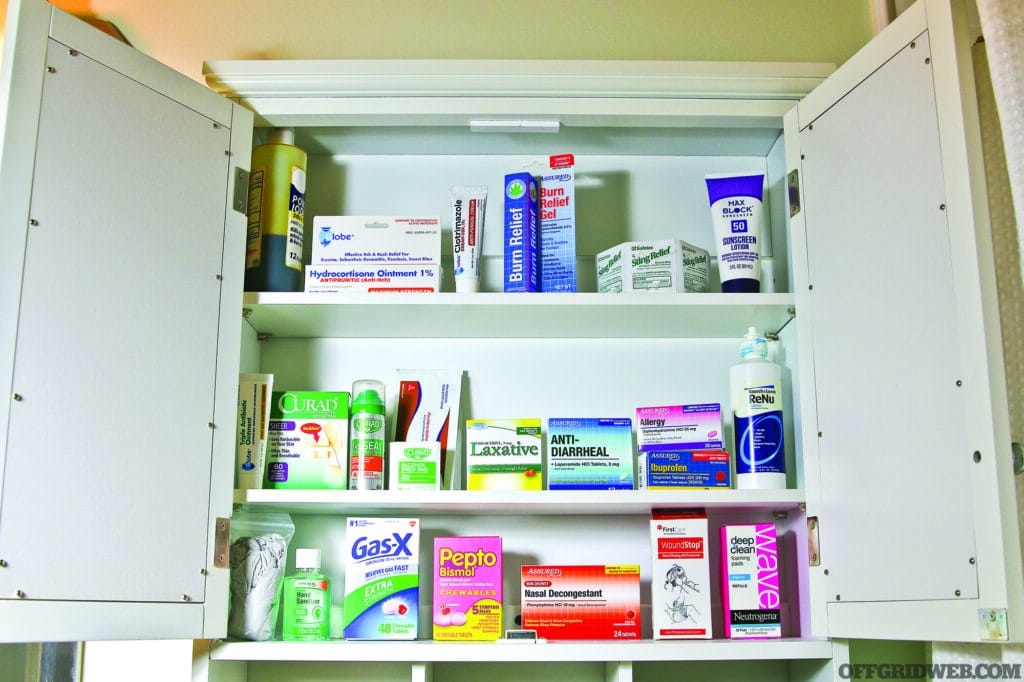
Above: Every family medic needs a survival medicine cabinet.
Acetaminophen 325 mg (Tylenol)
A popular pain reliever and fever reducer. Although it’s not used as an anti-inflammatory, this drug is excellent for treatment of pain and fevers and, in lower doses, popular for children. Tylenol comes in regular (325 mg) and extra strength (650 mg); adults take one to two every four hours.
Ibuprofen 200 mg (Motrin, Advil)
A popular pain reliever, anti-inflammatory, and fever reducer. This medication is useful for many different problems, which makes it especially useful as a stockpile item. It can ease pain from strains, sprains, arthritis, and traumatic injury. As well, it can help reduce inflammation in the injured area. Ibuprofen is also useful in reducing fevers from infections. The downside to ibuprofen is that it can cause stomach upset and is risky in those with kidney and liver disease. Ibuprofen 200 mg can be used one or two every four hours, three every six hours, or four every eight hours (maximum 3,200 mg per 24 hours).
(An aside: Patients with heat stroke receive little benefit from efforts to reduce their body core temperature with ibuprofen or acetaminophen; these drugs work best when the fever is caused by an infection, and don’t seem to work as well when infection isn’t involved, such as in heat stroke.)
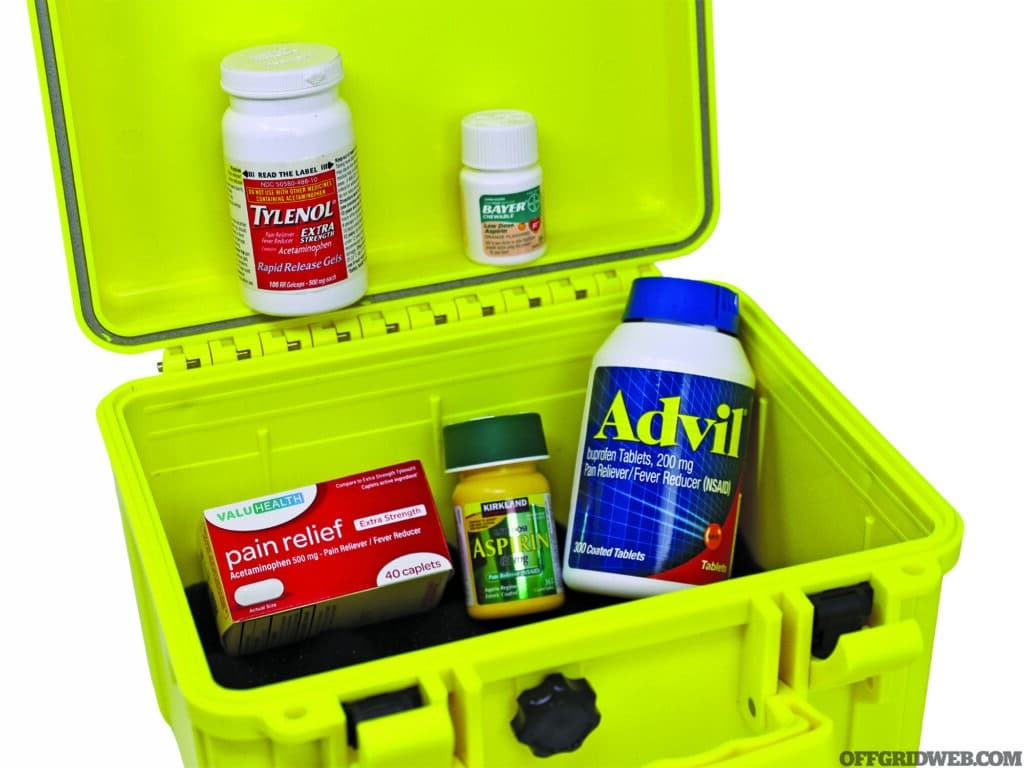
Aspirin, 325 mg
If you already have ibuprofen and acetaminophen in your medical storage, why consider aspirin? Aspirin has been around since the late 19th century as a pain reliever, fever reducer, and anti-inflammatory. It has anti-coagulant (blood thinning) properties as well. Aspirin is also useful to treat older folks with coronary artery disease and a history of heart attack or stroke. If you suspect someone is currently having a heart attack, have them chew an entire adult aspirin immediately. It’s interesting to note that the active ingredient in aspirin can also be obtained by chewing on a cut strip or a tea made of the underbark of a willow, aspen, or poplar tree. Take two adult aspirin (325 mg) for pain, fever, and inflammation up to every four hours. One baby aspirin (81 mg) daily is used with coronary artery disease and as an anticoagulant. In survival settings, higher doses may be appropriate to replace stronger blood-thinning drugs like Coumadin (warfarin), but the amount needed hasn’t been fully researched. Watch for stomach upset and be careful in those with kidney and liver disease.
Loperamide (Imodium) 2 mg
There’s a high likelihood of food and water contamination issues in the aftermath of a disaster, so this medication is essential as an anti-diarrheal. By slowing intestinal motility, it helps prevent water loss and, thus, dehydration. Dehydration due to diarrheal disease killed more soldiers in the Civil War than bullets or shrapnel. The usual dose is 4 mg (two tablets) after the first loose bowel movement, and 2 mg (one tablet) after each subsequent loose bowel movement. No more than 8 mg (four tablets) should be taken in any 24-hour period. In addition, consider stocking some rehydration salts, a vital mix of electrolytes added to water to restore balance.
Pepto-Bismol (Bismuth sub-salicylate) 262 mg
This versatile OTC drug can handle a number of problems, including heartburn, indigestion, nausea, gas, and diarrhea. It’s considered the drug of choice for traveler’s diarrhea. Be aware that it turns bowel movements a black color. It comes in regular and extra strength. Dosing may vary, but 524 mg (two regular-strength tablets) orally every 30 to 60 minutes is commonly recommended. Use no more than eight doses of regular Pepto-Bismol in 24 hours. Total therapy should last no more than two days.
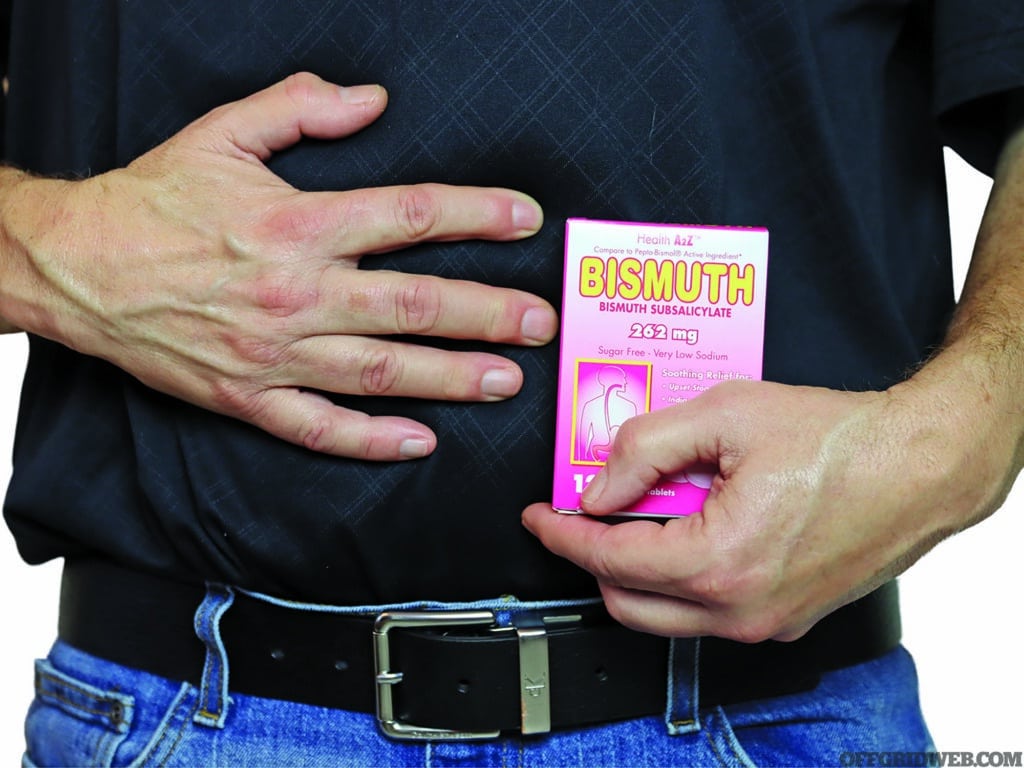
Above: Pepto will even work for traveler's diarrhea.
Laxatives/Stool Softeners
Many long shelf-life foods are binding and cause constipation. Therefore, stool softeners and laxatives may be helpful additions to medical storage. There are many different types that work in different ways to help evacuation. Laxatives and stool softeners aren’t exactly the same thing, however. A laxative is a substance that helps you have a bowel movement. Stool softeners like docusate (Colace, Senokot) wet and soften the stool. All stool softeners have a laxative effect, but not all laxatives soften the stool. Mineral oil, bisacodyl (Dulcolax), and glycerin are examples of the latter. Most of these medications are meant for short-term use and only when necessary.
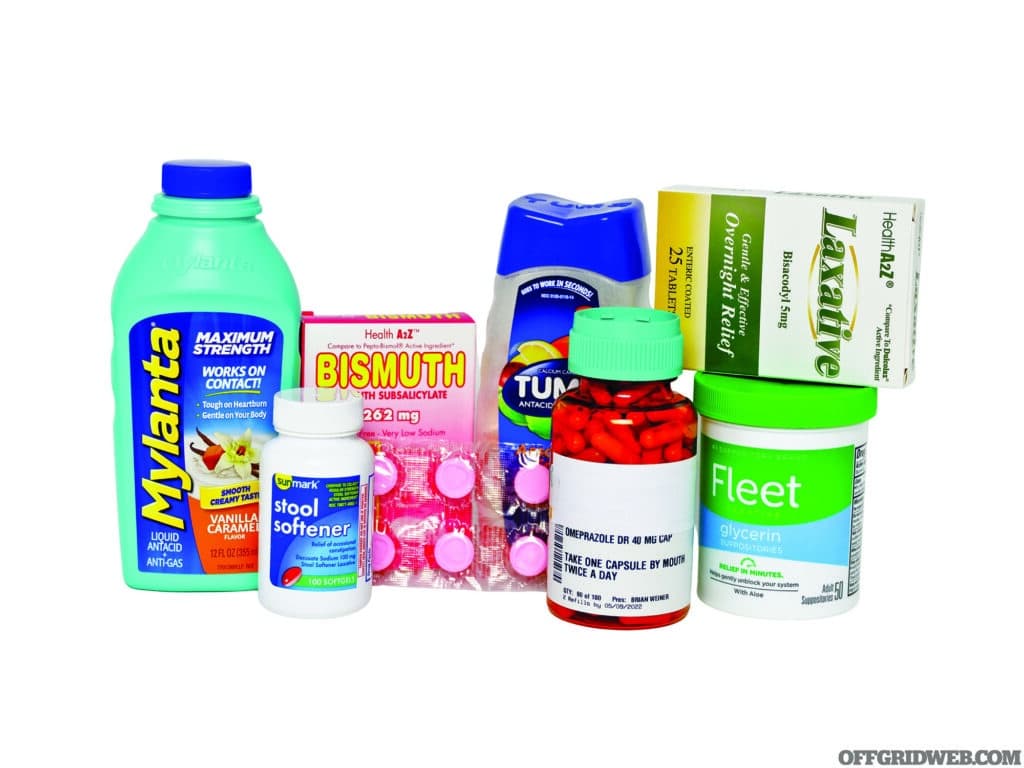
Above: Gastrointestinal meds.
Meclizine 12.5, 25, 50 mg (Bonine, Antivert)
With diarrheal disease, you often have nausea and vomiting, so you’ll want to have meclizine on hand. It’s a medication that helps prevent nausea and vomiting. A common option to prevent motion sickness, meclizine helps with dizziness and tends to act as a sedative as well. As such, it may have uses as a sleep aid or anti-anxiety medication. Take one 25 mg tablet an hour before boarding, or 50-100 mg daily in divided doses for dizziness, anxiety, or sleep.
Omeprazole 20-40 mg (Prilosec) or other antacids
In a situation where we eat food to which we’re not accustomed, issues with stomach acid can arise. Antacids will calm heartburn, queasiness, and stomach upset. Dosing may vary, but 20 mg of omeprazole once a day before a meal is a good start. A number of viable alternatives are available like cimetidine (Tagamet), famotidine (Pepcid), and others. If you have already stocked ranitidine (Zantac), be aware that older versions have been found to cause certain cancers. The current version, however, is the same as Pepcid. Calcium carbonate (Tums) or magnesium sulfate (Maalox) are also fine to stockpile in their solid forms. Rolaids is an OTC that combines both calcium and magnesium. These medications are useful for acid reflux and ulcer disease.
Pseudoephedrine 30 mg, 60 mg (Sudafed)
Pseudoephedrine is used to treat nasal or sinus congestion caused by respiratory allergies and infections. It’s also used to relieve ear congestion caused by otitis media and other ear inflammation. Take up to 60 mg every four to six hours. Sudafed has been used in the production of methamphetamine, so you usually have to ask the pharmacist for it. Pseudoephedrine is also found in a number of anti-allergy meds which contain it in combination with other ingredients. These may add the suffix “-D” to the brand, such as Claritin-D, Zyrtec-D, and Mucinex-D.
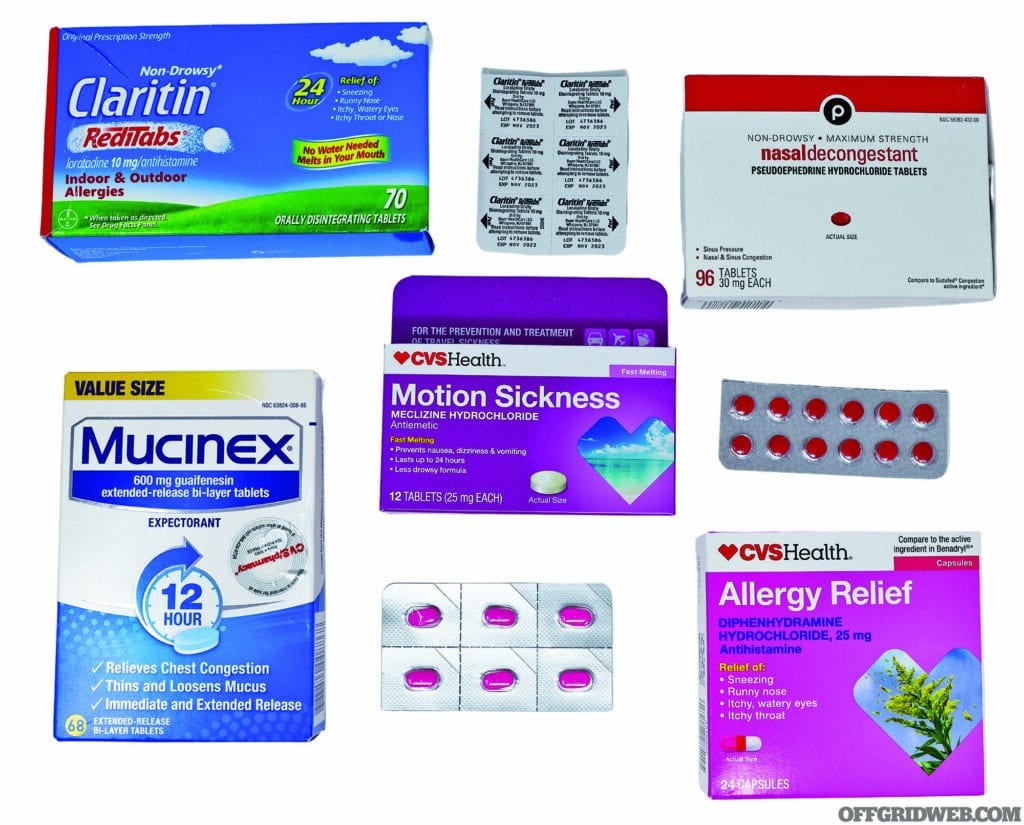
Above: Meds to ease respiratory symptoms and allergies will improve work efficiency.
Diphenhydramine 25 mg, 50 mg (Benadryl)
An antihistamine that helps alleviate the itching, rashes, nasal congestion, and other symptoms of allergic reactions. It also helps dry the nasal passages but may also cause dehydration in some. At the higher 50 mg dose, it makes an effective sleep aid. Use 25 mg every six hours for mild reactions, 50 mg every six hours for severe reactions or sleep.
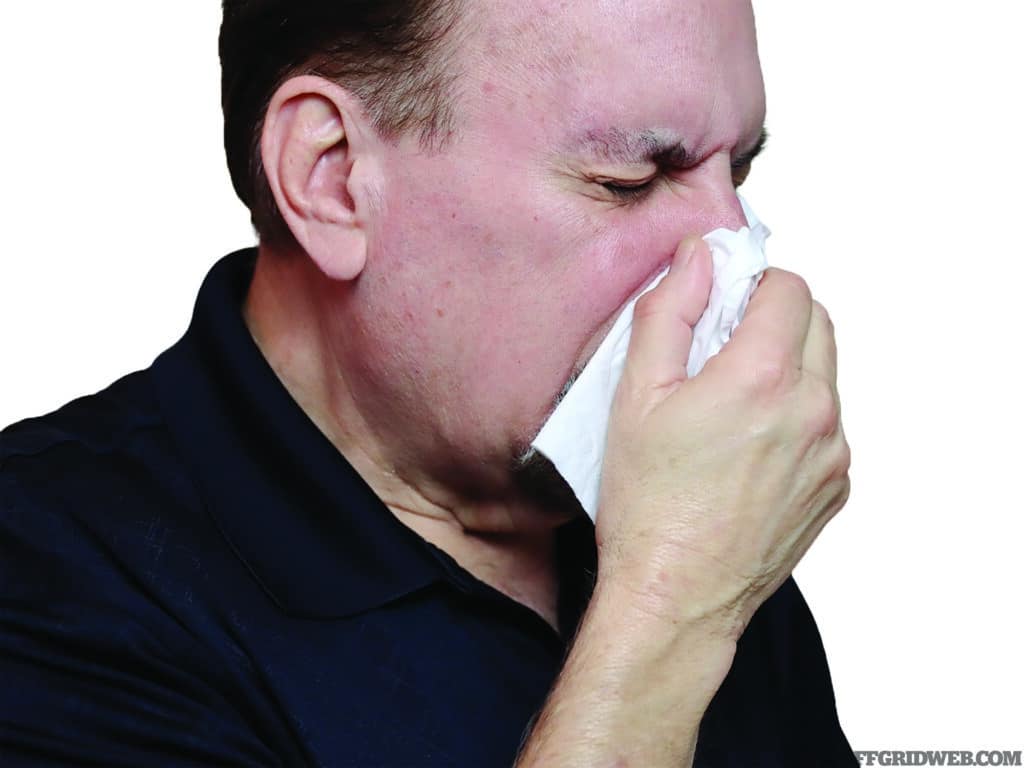
Above: Meds to deal with respiratory symptoms will help.
Antibiotic Ointment (Neosporin, Bacitracin, Bactroban)
In situations where we’re left to fend for ourselves, we’ll be chopping wood and performing all sorts of tasks that will expose us to risk of injury. When those injuries break the skin, it puts us in danger of infections which may cause serious illness. Antibiotic ointments are applied at the site of injury to prevent this from happening. It should be noted that triple antibiotic ointment won’t cure a deep infection; you would need oral or IV antibiotics for that, but using the ointment immediately after an injury will give you a good chance at preventing it. Apply three to four times a day.
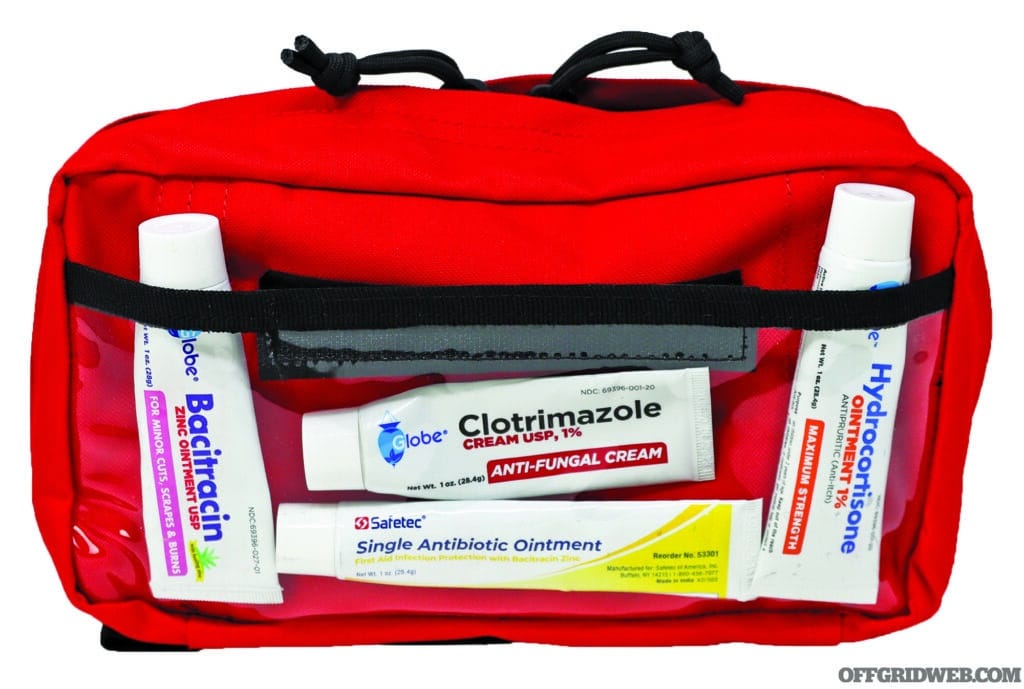
Above: Rashes and other skin issues will be commonplace.
Hydrocortisone cream (1%)
Hydrocortisone cream is a mild steroid used to treat various types of skin inflammation, like cases of dermatitis that cause redness, flakiness, itching, and thickening of the skin. Its versatility makes it a good alternative for allergic dermatitis, eczema, diaper rash, etc. Apply three to four times a day to affected area.
Clotrimazole, Miconazole cream/powder (Lotrimin, Monistat) (1-2%)
Infections can be bacterial, but they can also be caused by fungus. Common examples of this would be athlete’s foot (tinea pedis), vaginal infections (monilia), ringworm, and jock itch (tinea cruris). Clotrimazole and Miconazole are examples of anti-fungal medications that would be useful to treat these conditions, which will be just as common off the grid as they are now, if not more. Apply twice a day for external infections. Although most anti-fungal vaginal creams are applied internally once daily, be sure to use as directed on the packaging, as they may come in different strengths. In some, the whole treatment course is over in one day; in others, three days or a week.
Multivitamins
In survival settings, the lack of access to a good variety of food may lead to dietary deficiencies, not just in calories but in vitamins and minerals. Vitamin C deficiency, for example, leads to scurvy. To prevent these issues, you should have plenty of multivitamins in your medical storage. Despite recommendation on the bottle, you won’t have to take these on a daily basis; many multivitamins give you more than you need if taken daily, and you’ll just excrete what your body can’t absorb.
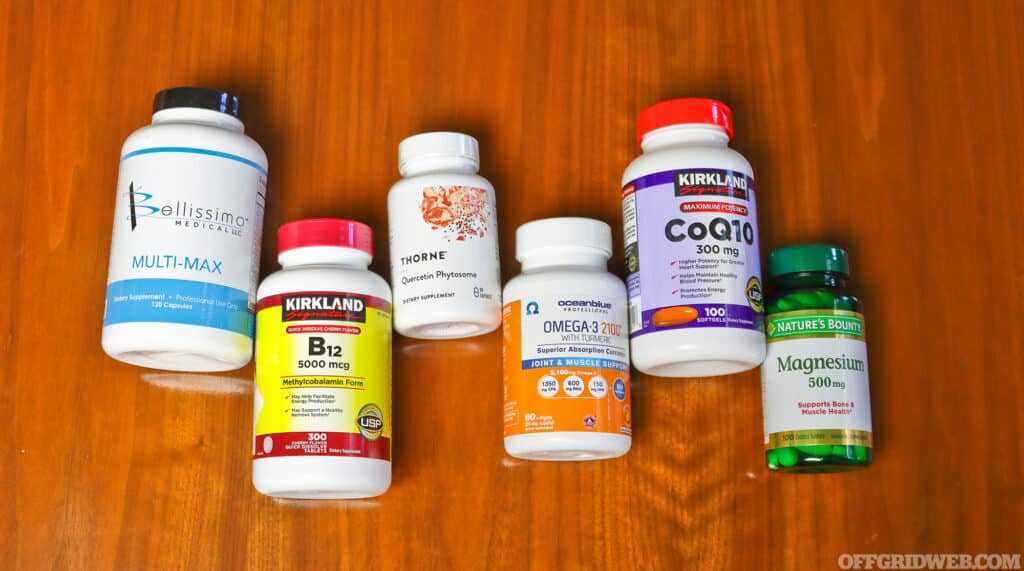
Above: Vitamins and supplements can avoid deficiencies.
[NOTE: The paragraph below contains information regarding veterinary antibiotics and the titles of my books that contain information about them for survival purposes.]
Antibiotics
Antibiotics are normally prescription drugs in the United States, but certain veterinary equivalents used in the aquarium and avian pet trades may be options for long-term survival scenarios only. For more information, consider a copy of The Survival Medicine Handbook: The Essential Guide For When Help Is Not On The Way (4th Edition) or Alton’s Antibiotics and Infectious Disease: The Layman’s Guide. Be aware that antibiotics only treat bacterial disease; they have little or no effect on viral illnesses.
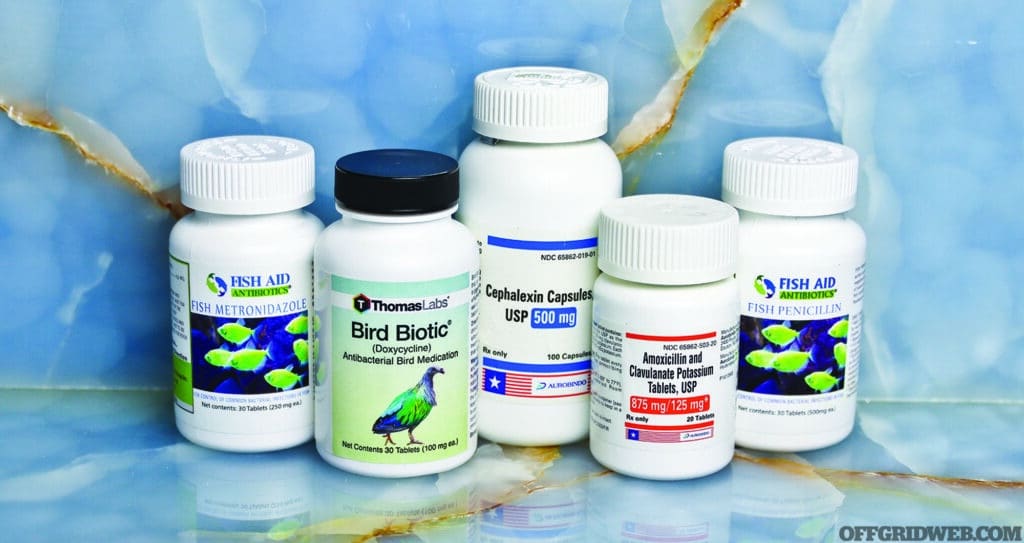
Above: Keep a variety of antibiotics in storage.
The good news is that you can probably obtain a significant amount of all of the above drugs for a reasonable amount of money. To retain full potency, these medications should be obtained in pill or capsule form; avoid the liquid versions of any of these medicines if at all possible.
When storing, remember that medications should be stored in cool, dry, dark places easy to access but away from children. A medicine stored at 90 degrees will lose potency much faster than one stored at 50 degrees.
Access to insulin is essential for Type I diabetics. Basic forms of insulin (NPH, regular) are available in many states without a prescription. Insulin is best refrigerated (36 degrees F to 46 degrees F), but not frozen. Sealed vials usually are good for a year.
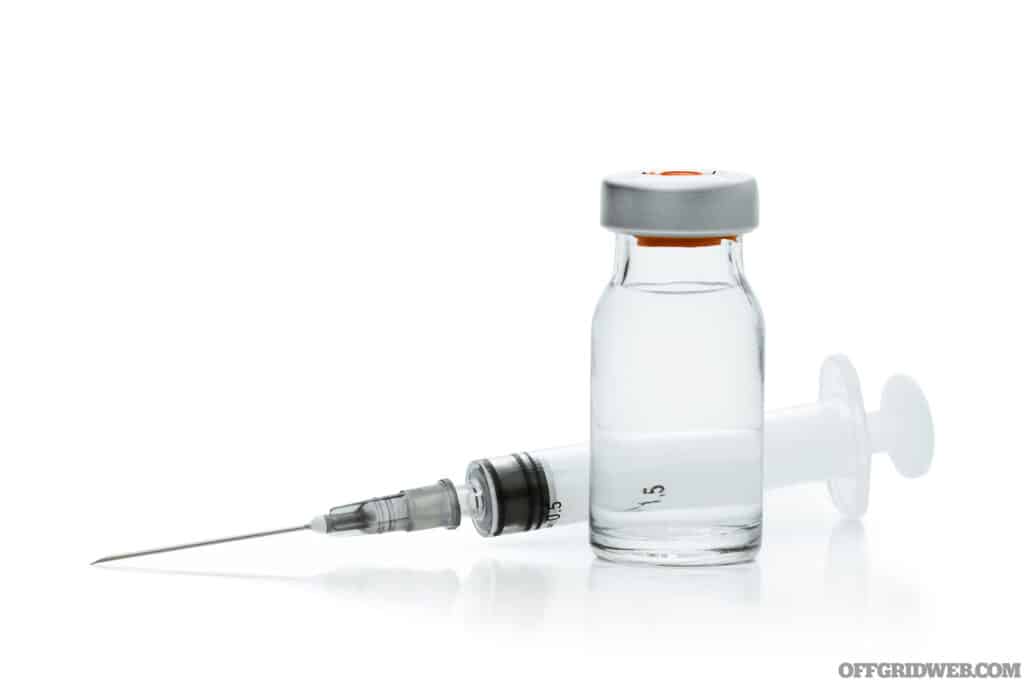
Above: Unopened insulin lasts a year. Opened lasts 28 days.
Note: For the least discomfort, refrigerated insulin should be warmed after dosing but before injecting.
If refrigeration isn’t an option, keep insulin vials between 59 degrees F to 86 degrees F. These will last about 28 days without losing potency.
Other tips to help insulin last longer:
In addition, your medical storage should include OTC supplies other than medicines. A good variety of bandages and dressings are necessary to deal with wounds and orthopedic injuries. Antiseptics such as povidone-iodine solution (Betadine), chlorhexidine (Hibiclens), Benzalkonium Chloride (BZK), and isopropyl alcohol will help prevent infections and save lives.
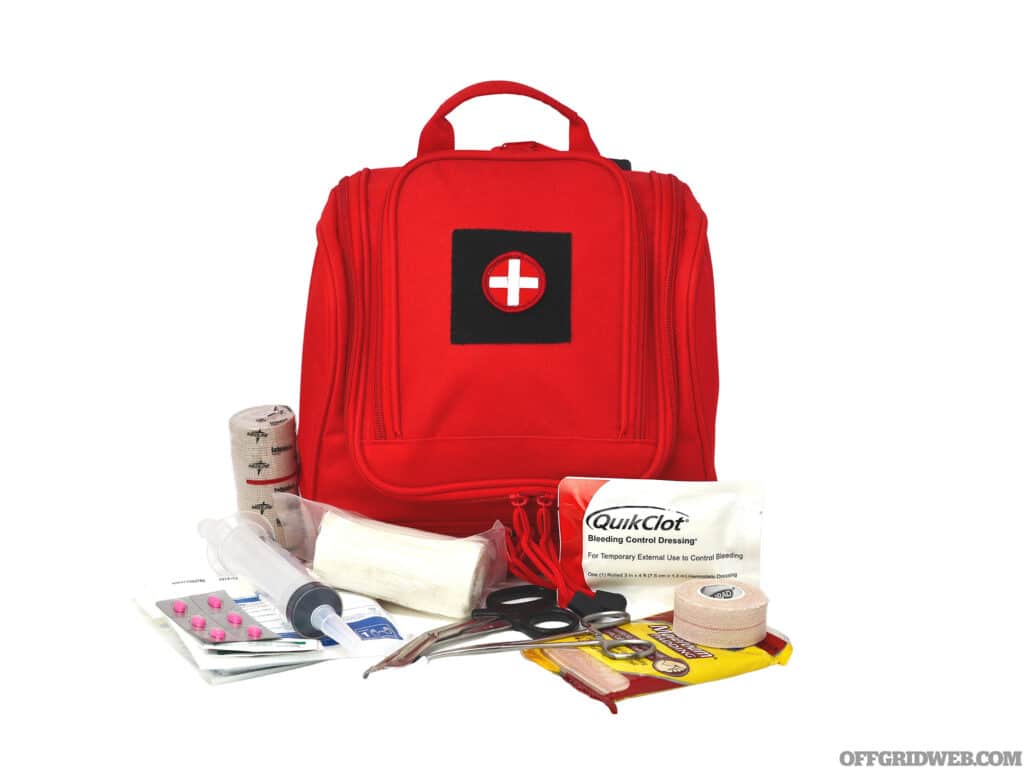
Above: A variety of non-drug supplies is also essential.
Over-the-counter drugs are just another weapon in the survival medicine cabinet; accumulate them as well as prescription drugs for chronic illnesses and other problems. Review medical histories with group members to get an idea of what might be necessary to keep them healthy. Natural alternatives are also important, such as aloe gel for burns. Certainly, you’ll eventually run out of the commercially made products. Supplies to treat bleeding wounds or other trauma are also imperative to have available. With a good stockpile, you’ll have everything you need to keep it together health-wise, even if everything else falls apart.
Joe Alton MD, FACOG, FACS is an actively licensed physician and surgeon, medical preparedness advocate, and New York Times/Amazon bestselling author on medical topics related to austere settings. He’s a member of the Wilderness Medical Society and a certified Advanced Wilderness Expedition Provider. His Survival Medicine Handbook (4th Edition) won first place in the 2022 Book Excellence Awards in medicine, and his book Alton’s Antibiotics and Infectious Disease won the same award in 2020. His survival medicine website at doomandbloom.net has over 1200 articles, podcasts, and videos.

 STAY SAFE: Download a Free copy of the OFFGRID Outbreak Issue
STAY SAFE: Download a Free copy of the OFFGRID Outbreak Issue
No Comments